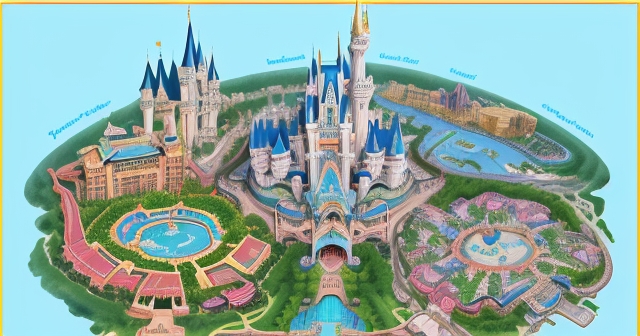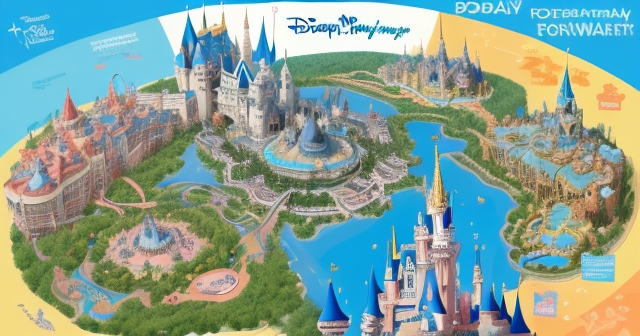Understanding Disney’s Economic Footprint and Market Resilience Amidst Global Uncertainty
In a period marked by persistent global economic headwinds, including concerns about slowing GDP growth, elevated inflation, and geopolitical tensions, The Walt Disney Company presents a fascinating case study in financial strength and operational resilience. As investors navigate these complex market conditions, understanding how iconic companies like Disney perform and contribute to the broader economy is crucial. We want to explore not just Disney’s balance sheet, but also its tangible impact on the regions where it operates, particularly how its theme parks defy typical economic cycles.
Have you been watching the news and seeing mixed signals about the economy? Perhaps you’ve heard talk of potential recessions or felt the pinch of rising prices yourself. It’s natural to wonder how major corporations are faring in this environment. Disney, a company synonymous with entertainment and experiences, offers us a unique perspective. It operates across diverse sectors – media, streaming, and massive physical destinations. This diversification, combined with the emotional connection people have to its brand, creates a complex interplay with macroeconomic forces.
Key aspects of Disney’s market position include:
- Wide range of products and services across different sectors.
- Strong emotional brand connection with consumers.
- Diverse revenue streams that buffer against economic downturns.
A Closer Look at the Q2 Triumph: Exceeding Expectations
Let’s begin by dissecting Disney’s recent financial performance, specifically its Fiscal Year 2025 Second Quarter earnings. The results were, in short, a significant beat on analyst expectations. This wasn’t just a small improvement; it marked a substantial turnaround compared to the prior year.
For the quarter, The Walt Disney Company reported net income of $3.28 billion. Compare this to a loss in the same period the previous year, and you can see the magnitude of the operational recovery and strategic execution underway. This impressive profit figure, derived from total revenues that also surpassed forecasts, sent a clear signal to the market about the company’s direction and momentum.
How did Disney achieve this? The strength came primarily from two key segments: Entertainment and Experiences. The Entertainment segment, which includes their media networks and the Direct-to-Consumer (DTC) streaming services like Disney+ and Hulu, saw a remarkable 61% increase in operating income. This surge indicates improving profitability in their streaming ventures, a critical focus area for the company’s future.
Meanwhile, the Experiences segment, encompassing the theme parks, resorts, cruise line, and consumer products, also posted robust results, with operating income climbing 9%. While a 9% increase might seem modest compared to the Entertainment segment’s jump, it’s crucial to view this within the context of a potentially slowing global economy. We will delve much deeper into the remarkable story of the parks shortly, as they represent a significant portion of the company’s revenue and carry considerable economic weight.
Following this strong FY25 Q2 report, Disney felt confident enough to raise its fiscal year 2025 adjusted earnings forecast to $5.75 per share. Raising guidance is a strong sign of management confidence in continued performance. It suggests that the positive trends observed in Q2 are expected to persist, fueling optimism among investors and contributing to the subsequent surge in Disney’s stock price.
The Unyielding Power of the Parks: Defying Economic Gravity?
Now, let’s pivot to arguably the most fascinating part of Disney’s recent narrative: the exceptional performance and resilience of its theme parks. In an economic climate where consumer discretionary spending might be expected to soften, especially for high-ticket items like family vacations, Disney parks have shown remarkable strength.

Data from the recent earnings report highlights this resilience starkly. US parks revenue surged an impressive 9% in the last quarter. Think about that for a moment. While economic indicators like US GDP growth may be slowing (it shrank in Q1), people are still prioritizing trips to Disney destinations. This isn’t just a statistical anomaly; it’s a pattern observed by those closest to the consumer.
Travel agents specializing in Disney vacations have reported significant increases in bookings. These are the people on the front lines, hearing directly from families planning their trips. Their observations align with the corporate sentiment. Disney CEO Bob Iger and Experiences head Josh D’Amaro have both described park demand as “incredibly resilient” and future bookings as looking “strong.”
What explains this phenomenon? Why are families seemingly prioritizing Disney trips even when they might be feeling cautious about their finances? Several factors likely contribute:
- Pent-up Demand: The lingering effects of the pandemic and delayed travel plans continue to fuel demand for experiences.
- Emotional Value: Disney parks represent cherished memories and aspirational family vacations. For many, this value transcends immediate economic worries.
- Prioritization: Some families may be cutting back in other areas of their spending to save for a significant Disney trip. They might adjust spending habits *within* the parks (e.g., opting for Quick Service dining over Table Service, buying fewer souvenirs) but still commit to the core experience.
- Brand Loyalty: Disney has cultivated generations of loyal fans who return repeatedly.
- Unique Offering: The immersive, high-quality experience offered by Disney is difficult to replicate elsewhere, giving it pricing power and demand stability.
We can also look back historically for context. During the global financial crisis, domestic Disney parks’ revenue fell, but typically less severely and recovered faster than revenue at international parks. This historical pattern suggests that while not entirely immune, domestic parks, especially those in the US, possess a degree of counter-cyclical resilience or at least a faster recovery profile compared to other segments or geographies during economic downturns.
Understanding this resilience is key for investors and economists alike. It challenges the conventional wisdom that consumer discretionary spending uniformly collapses during economic uncertainty. Instead, it suggests a hierarchy of spending priorities, where highly valued, experiential purchases like a Disney vacation maintain significant pull.
Quantifying Disney’s Economic Contribution: More Than Just Magic
Beyond its direct financial performance and stock valuation, Disney holds substantial sway over regional economies. Its large-scale operations, particularly Walt Disney World Resort in Florida, act as powerful economic engines. This is where the link between “Disney” and “GDP,” specifically *regional* GDP, becomes incredibly clear and quantifiable.

A comprehensive study conducted by Oxford Economics in FY22 provides compelling data on this impact. It found that Walt Disney World Resort alone generated a staggering $40.3 billion in economic impact across the state of Florida in that fiscal year. This figure represents the total value of goods and services produced as a result of Disney’s operations, including direct spending, supply chain purchases, and the spending of employees and those in related industries.
Think of this $40.3 billion as a significant slice of Florida’s overall economic pie, a direct contribution to the state’s GDP. It illustrates how a single company, through its operations and the ecosystem it supports, can profoundly influence the economic vitality of a large region.
The impact extends directly to jobs. The study revealed that Disney’s Florida operations supported a remarkable 263,000 direct and indirect jobs statewide in FY22. To put that into perspective, this means that roughly 1 in every 32 jobs across Florida is connected in some way to Disney’s presence. These jobs cover a wide spectrum, from theme park cast members and resort staff to construction workers, suppliers, and employees in businesses that benefit from tourist traffic. The study also estimated these jobs generated $12.1 billion in labor income, putting significant money into the pockets of Florida residents.
Furthermore, Disney is a major contributor to tax revenues at various levels. In FY22, the company contributed $6.6 billion in total tax revenue. Of this, a substantial $3.1 billion went directly to state and local governments in Florida. These tax contributions help fund public services, infrastructure, and education across the state, demonstrating the tangible fiscal benefits of Disney’s operations.
| Economic Contribution | Value |
|---|---|
| Economic Impact of Disney in Florida | $40.3 billion |
| Total Jobs Supported | 263,000 |
| Total Tax Revenue | $6.6 billion |
The economic influence also cascades down to smaller businesses. The study highlighted that Disney contracts with approximately 2,500 Florida-based small businesses. These relationships support local entrepreneurs, create jobs within communities, and strengthen the regional supply chain. From food suppliers to laundry services, specialized contractors, and merchandise manufacturers, these small businesses are integral to the seamless operation of Walt Disney World and represent another layer of its economic footprint.
This detailed breakdown from the Oxford Economics study underscores a fundamental point: Disney’s operations are not just about entertainment; they are critical components of the economic fabric in places like Florida. Their spending, investment, employment, and tax contributions directly influence regional prosperity and are deeply intertwined with local GDP and employment metrics. This quantifiable impact provides tangible evidence of Disney’s importance beyond the realm of market capitalization and quarterly earnings reports.
Navigating the Broader Economic Landscape and Charting the Future
While Disney’s recent performance has been strong, it doesn’t operate in a vacuum. Its success is still influenced, to varying degrees, by the broader macroeconomic landscape. As we noted earlier, this environment is characterized by significant uncertainty.
Key macroeconomic factors influencing Disney’s operations include:
- Slowing US GDP growth, including a contraction in Q1.
- The stability of interest rates amid past rate hikes.
- Inflation affecting consumer purchasing power and institutional costs.
Let’s consider some of the key macroeconomic factors at play. The US GDP growth, while positive, has shown signs of slowing, including a contraction in the first quarter, raising concerns about a potential recession. The Federal Open Market Committee (FOMC) has kept interest rates stable recently, but the cumulative effect of past rate hikes continues to ripple through the economy, influencing borrowing costs for businesses and consumers.
Inflation remains a concern, impacting consumer purchasing power and increasing operational costs for businesses like Disney. While unemployment figures have been relatively low, there are growing concerns about potential increases, which could impact consumer confidence and spending.
Global trade tensions, such as ongoing US-China trade talks and potential new tariffs from regions like the EU, add another layer of complexity. These factors can affect supply chains, raw material costs, and international tourism patterns, all of which can touch upon Disney’s diverse businesses.
Disney management acknowledges this uncertainty. While expressing confidence in their strategy and growth drivers, they are undoubtedly keeping a close eye on these external conditions. The company’s ability to raise prices at its parks, for example, is partly dependent on consumer confidence and the overall economic climate. A significant downturn *could* eventually impact demand, although as we’ve seen, the parks have demonstrated impressive resilience thus probably not as severely as other industries.
Against this backdrop of macroeconomic uncertainty, Disney is actively charting its future course through strategic initiatives and investments. One significant announcement has been the plan for a new theme park resort in Abu Dhabi, UAE, in partnership with Miral. This move signals Disney’s intent to tap into growing international markets outside of its traditional strongholds in the US, Europe, and Asia. Expanding their physical presence in regions with potentially different economic cycles or growth trajectories is a way to diversify future revenue streams and capture new audiences.
Beyond theme parks, Disney is also focusing on strategic growth in its media segments. Efforts are underway to improve the profitability of the DTC services (Disney+, Hulu) and explore new models, such as the planned ESPN DTC offering. These initiatives aim to leverage Disney’s vast content library and brand strength in the evolving digital landscape, creating additional drivers for financial performance independent of theme park attendance.
So, while external economic conditions provide the challenging environment, Disney’s internal strategy involves optimizing existing assets (profitable streaming, resilient parks) and investing in future growth areas (international parks, new digital offerings). This dual approach is designed to position the company for continued success regardless of the short-term macroeconomic fluctuations.
The Intricate Dance: Disney’s Operations and Economic Well-being
Let’s take a step back and consider the intricate relationship between a company like Disney and the economic well-being of the regions it inhabits. The Oxford Economics study on Florida serves as a powerful illustration of this connection. It’s not just about the jobs *within* Disney’s gates. It’s about the ripple effect.

When Disney hires employees, they spend their wages in the local community, supporting restaurants, retail stores, and housing. When Disney purchases supplies – from food for restaurants to materials for construction or merchandise – it supports local producers and distributors. When millions of tourists visit, they stay in hotels, eat at local diners, buy gas, and visit other attractions, fueling the broader tourism ecosystem. When Disney pays taxes, those funds contribute to public infrastructure improvements like roads and utilities, which further support business growth and quality of life in the region.
This multifaceted relationship means that Disney’s health is closely tied to the health of Central Florida’s economy, and conversely, Central Florida’s economy benefits significantly from Disney’s robust operations. The resort’s economic impact isn’t static; it fluctuates with Disney’s investment levels, attendance numbers, and operational efficiency. For instance, significant capital investments in new attractions or resorts translate into construction jobs and local purchasing. Strong park attendance leads to higher employment needs and greater tourist spending in surrounding areas.
| Impact Factor | Description |
|---|---|
| Job Creation | Disney’s operations support numerous jobs in various sectors. |
| Economic Growth | Disney contributes significantly to the local GDP through its activities. |
| Infrastructure Improvement | Tax contributions help fund community projects and public services. |
Recognizing this symbiotic relationship is key for both investors analyzing Disney and for policymakers in regions hosting large tourism-dependent operations. The data on economic impact, job creation, and tax revenue moves the conversation beyond anecdotal evidence to provide a clear, quantifiable picture of the company’s role as a major economic player. It reinforces the idea that Disney’s success contributes directly to regional prosperity, influencing metrics that feed into local and state GDP figures.
Beyond the Numbers: The Qualitative Aspect of Disney’s Impact
While the Oxford Economics study provides crucial quantitative data, it’s also worth considering the qualitative aspects of Disney’s impact. Disney World, for example, has been a foundational element of Central Florida’s identity and economic development for decades. Its presence transformed a primarily agricultural region into a global tourism hub. This transformation brought not only jobs and revenue but also infrastructure development, increased cultural diversity, and the growth of related service industries.

The concentration of talent and expertise in hospitality, entertainment production, logistics, and customer service that has grown around Disney World is a significant asset for the region. This creates a skilled workforce and a business environment conducive to further growth in related sectors. The company’s standards for guest experience and operational efficiency also influence practices across the local tourism industry.
Furthermore, Disney’s philanthropic efforts, community involvement, and support for local charities add another layer to its impact. While not directly captured in economic impact studies focused on spending and jobs, these contributions build social capital and address community needs, further integrating the company into the local fabric. Organizations benefiting from Disney’s support, whether through donations or volunteer hours from cast members, provide essential services that contribute to the overall well-being of the community.
Considering both the quantitative data on economic output, jobs, and taxes, and the qualitative aspects like community development and industry influence, we gain a more complete picture of Disney’s powerful economic footprint. It is a major driver of economic activity, a significant employer, and a foundational element of the regional economy, contributing meaningfully to local GDP and overall prosperity.
Looking Ahead: What Does Disney’s Resilience Mean for Investors?
So, what does this comprehensive view of Disney’s recent performance, park resilience, and economic impact mean for you as an investor, especially if you’re a beginner or looking to deepen your understanding of technical analysis and market dynamics?
Firstly, Disney’s strong Q2 earnings and raised guidance, coming amidst macroeconomic uncertainty, suggest that the company is executing well on its strategic priorities. Improving profitability in streaming and continued strength in Experiences are positive signs. This performance demonstrates that even in a challenging environment, companies with strong brands, unique assets, and effective management can find avenues for growth and profitability. For investors, this highlights the importance of looking beyond headline economic figures to understand the specifics of a company’s business model and execution.
Secondly, the resilience of the theme parks offers a valuable lesson in demand elasticity and consumer behavior. It tells us that certain premium experiences may be less sensitive to economic fluctuations than might be assumed. While technical analysis focuses on price charts and trading patterns, understanding these fundamental drivers of demand is crucial for building conviction in a company’s long-term prospects. Why is the stock moving? Part of the answer often lies in the underlying business performance and its relationship with the economy.
Thirdly, recognizing Disney’s significant economic impact in key regions provides context for its stability and influence. A company that is deeply integrated into the economic fabric of a state, supporting hundreds of thousands of jobs and contributing billions in taxes, has a different risk profile than one with a more isolated operational footprint. This economic embeddedness contributes to its overall stability and importance. As you learn about analyzing stocks, considering a company’s broader economic role can add valuable perspective.
However, it’s essential to remain grounded. While Disney has shown resilience, it is not entirely immune to economic downturns. A severe or prolonged recession could eventually impact even the most dedicated Disney fans’ ability or willingness to travel. Macroeconomic factors like persistent inflation or significant job losses could shift consumer priorities. Investors should continue to monitor economic indicators and Disney’s future earnings reports closely.
Furthermore, technical analysts might observe how the market has reacted to recent news – the sharp rise in stock price post-earnings is a clear signal of positive sentiment. They might then look for chart patterns and volume trends to gauge the sustainability of this move. Combining fundamental insights (like strong earnings, park resilience, economic impact) with technical analysis can offer a more holistic view for making informed decisions.
In conclusion, Disney’s recent narrative provides a compelling example of a large, diversified company navigating a complex economic world. Its strong financial performance, the remarkable resilience of its theme parks, and its quantifiable economic impact, particularly in Florida, stand out amidst broader uncertainty. Understanding these facets helps us appreciate the underlying strengths that drive the company’s value and influence, offering valuable lessons for anyone seeking to master the art and science of investing and trading.
disney gdpFAQ
Q:What is Disney’s recent financial performance?
A:Disney reported a net income of $3.28 billion for Q2 FY2025, marking a significant turnaround from a loss in the previous year.
Q:How does Disney contribute to the Florida economy?
A:Disney generated an economic impact of approximately $40.3 billion in Florida, supporting around 263,000 jobs.
Q:What are the key segments driving Disney’s revenue?
A:The key segments driving revenue include Entertainment (media networks and streaming) and Experiences (theme parks and resorts).

留言